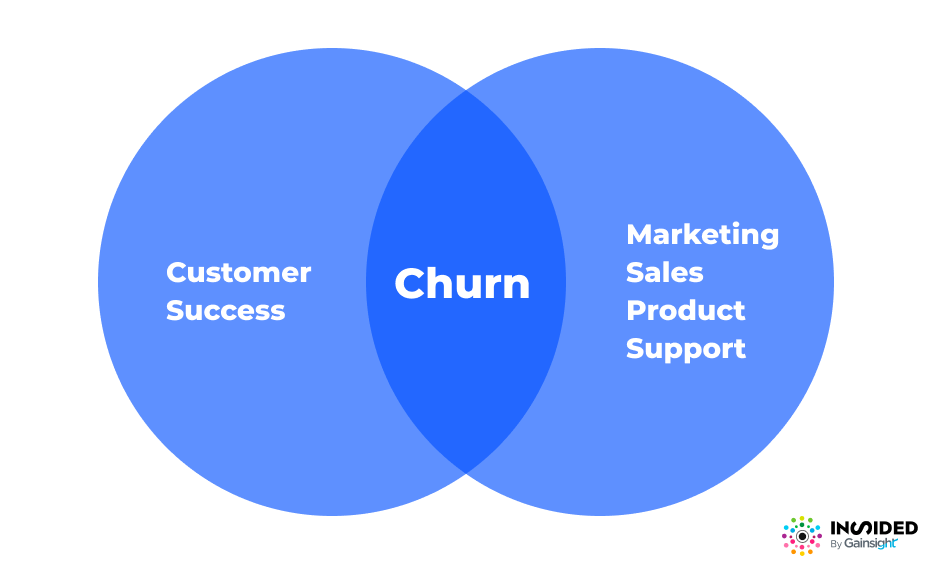Last week, we kicked off our Burn the Churn customer health challenge with a nice warm-up, talking about the new standard for customer health and going back to basics with a refresher course on customer health scores. (Sign up to make sure you don’t miss any of the good stuff!)
This week, it’s time to get to work.
With that, it’s also time to go back to basics. Your customer health score model can only be as good as your indicators for churn. Let’s talk about what you can do to make sure your indicators for churn are accurate.
But first, who’s responsible for churn?
Who’s responsible for churn?
A common mistake companies make is to hold Customer Success solely responsible for churn. And that’s not good news for anyone (especially your NRR).
The truth is: It’s a company-wide responsibility to reduce churn and improve retention.

Here’s how each department impacts churn.
Marketing
Marketing just cares about pipeline, right? True(-ish). BUT! If Marketing attracts the wrong buyers, that’ll lead to higher churn. It’s Marketing’s job to make sure messaging aligns with the product experience.
Sales
Just like Marketing has a responsibility to attract the right customers, Sales has a responsibility to sell to the right customers. ABC isn’t a thing, because if your customers can’t be successful with your product or service in the long term, the customer will churn. It’s their responsibility to identify customer pain points and make sure the product fits.
Product
Without a product, there are no customers. Product is responsible for meeting customer needs and solving their problems. Creating and maintaining an effective customer feedback loop (and closing that loop) is crucial to avoid churn.
Support
At some point in their journey, your customer will come to Support with questions. Perhaps they’ve encountered a bug, perhaps they’re struggling with a module, who knows? What we do know is that continuously delivering customer support that’s empathetic and effective leads to less churn.
Customer Success
The job of the Customer Success team is to do just that – ensure customer success. That means making sure your customers experience value with your product. Because if your customers experience value, they’re less likely to churn.
In broad strokes, that’s it. Now, of course, churn gets much more complex than the above, so you want to make sure to work with each team to define the metrics that lead to churn in their departments.
Now, let’s talk about churn indicators.
Check your churn indicators
First of all, let’s be real here: churn is expensive. And it’s not just about the lost ARR, it’s also about the resources you need to spend on offboarding, migration, and so on. Plus, you need to win new business to replace the lost revenue. That’s why understanding the reason for churn is the first – and most important – step toward reducing your churn rates. If your churn indicators are inaccurate, then, well, your customer health scores will also be inaccurate.
Now, in SaaS specifically, it’s all about subscriptions. But what are the reasons, the real motivators for those subscriptions getting canceled?
On a high level, this could be:
- Poor customer fit
- Missing functionality
- Too much functionality
- Product issues
- Lack of buy-in
- Pricing
But what it all boils down to is value, and more specifically, delivering long-term value. If your customers continuously experience value, they won’t churn – simple as that. Value, of course, looks different at every company, but generally speaking, your product delivers value if it helps customers achieve their business goals.
So what does “value” look like in the format of metrics? Time to dive into churn data.
Dive into churn data
This is it. Get your team together! That means bringing in one (or more) person from Marketing, Sales, Product, Support, and Customer Success, because it’s time to dive into churn data to define your churn indicators.
Here are a few questions to get you started:
Customer Success
Account-level:
- Which plans are being canceled the most/least?
- What’s the most common reason for cancellations?
- Which CSMs have the highest/lowest cancellations?
Experience level:
- Did the customer follow the success plan?
- Did the customer reach their value milestones?
- How engaged was the customer? Eg did they attend QBRs, replied to emails, shared feedback.
Product
- Which products/features were the most/least used?
- How long was the customer using a certain product/feature?
- Were there significant increases/decreases in product/feature usage?
- How many integrations did the customer use?
Support
- How often did the customer contact support?
- Were their problems solved in a timely manner?
- Did the customer self-serve? Ie used the knowledge base or community.
Sales
- Did you make promises your product can’t deliver on? Compare customer feedback with notes from the sales cycle.
Marketing
- Is your value proposition aligned with the product experience? Compare customer feedback with marketing messaging.
Once you’ve established the reasons for churn, identify the metrics that correspond to those. While churn in itself is a lagging indicator, these metrics will serve as leading indicators to help you get ahead of churn and prevent it before it happens.
Keep a finger on the churn pulse
Now, you might not have all the answers yet (or even all the data), especially if you’re fresh out the gates. But regardless of where you’re at in your burn the churn journey, one thing always holds true: customer needs change and your product evolves. That’s why it’s important to revisit your churn indicators, adjust and update them as needed.
Ready to burn the churn and improve your customer health scores?
Join inSided’s 8-week customer health challenge and get access to content, events, and tips on how you can go from red to green.
{{cta(‘0adde249-d63e-4dba-9525-368910086523’)}}


